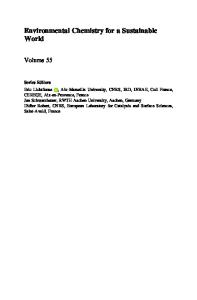Mechanism of the Oxygen Interaction with a Surface of Thin Nanosized Metal Oxide Film
- PDF / 81,922 Bytes
- 6 Pages / 595 x 842 pts (A4) Page_size
- 59 Downloads / 338 Views
A5.9.1
Mechanism of the Oxygen Interaction with a Surface of Thin Nanosized Metal Oxide Film 1
Vladimir I. Brinzari, 2Serghei V. Dmitriev, 1Ghenadii S. Korotcenkov
1
Department of Opto- and Microelectronics, Technical University of Moldova 168 Blv. Stefan cel Mare, Chisinau, MD-2004, Moldova 2 Department of Industrial and Environmental Chemistry, Moldova State University, 60 Mateevich Str., Chisinau, MD-2009, Moldova
ABSTRACT This paper presents result of investigation of the oxygen interaction with a surface of semiconductor metal oxide film. The idea to carry out such research is connected with the key role, which oxygen plays in the processes of impurity gas molecules detection in atmosphere and semiconductor surface sensibilization. Numerical modeling of the interaction was carried out for different temperatures and oxygen partial pressures. Results of modeling are compared with the results of experimental study of oxygen-semiconductor film system.
INTRODUCTION It is well known fact that the oxygen presence on the semiconductor gas sensor’s surface plays exclusive role in gas detection processes and its absence leads to the sensor’s incapability to detect gas impurities in atmosphere [1]. So, any such gas sensor should possess capability to reversibly adsorb oxygen on its surface for all period of its exploitation. As oxygen presence is preliminarily condition for successful gas impurity detection it will be useful for deeper understanding to consider the processes of adsorption/desorption of oxygen itself. The basis for such consideration was developed earlier chemosorptional model of thin film gas sensor (TFGS) (Brinzari, Dmitriev and Korotcenkov (BDK)-model) [2]. Developed on the base of Volkenstein’s theory [3] of chemosorptional processes on semiconductors BDK-model has allowed explaining and establishing some correlations between gas sensitivity limit and electrophysical and geometrical parameters of gas sensitive films, operating temperature and concentration of detected gas (CO). However, oxygen adsorption/desorption processes were subjected only in some degree in this model. The same can be said regarding models of H. Geistlinger [4], by J.Agapito and J.Santos [5] developed also on the base of [3]. In given work we present results aimed at study of the processes of oxygen interaction with thin film’s surface in the case of active gas absence. Without clear understanding of the mentioned processes it is difficult to interpret subsequently the kinetics of GS sensing in the presence of detected gas in the ambient atmosphere.
THEORY Balance and kinetics of chemisorbed particles Expanded equations of gas particles’ balance on semiconductor surface (Fig.1a) for the neutral and charge forms of chemisorbed oxygen [3] are the basis for our theoretical study
A5.9.2
β2 N-
∗
o o α P (N − No − No )2 αO2 PO2 (N ∗ − NO − NO ) .O2 O2 O O2 2
2
O2os O2−s (1)
N
o O2
β O (NO )
2
(1)
O2
o 2
o
βO NO
β1
β1No W
O2 (g)
O2 (g)
ECS
σS
O so O so O s− WO −
β2 NO 2
( 2)
β1
N
o O2
Ecb
O2S −
( 2)
Data Loading...










